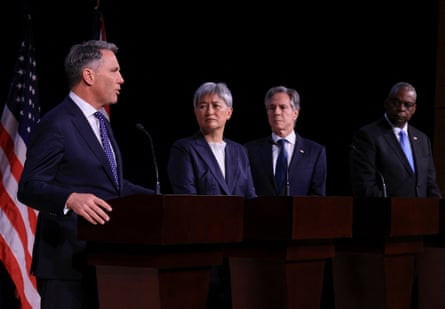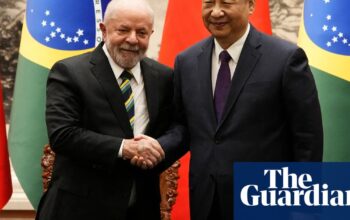The US says it plans “more frequent” deployments of bomber aircraft to Australia amid concerns over China’s “dangerous and escalatory behaviour” in the region.
The announcement after annual talks on Wednesday builds on a long-term trend of increased rotations of American forces to Australia, along with moves to upgrade Australian military bases and pre-position US army equipment in Australia.
Pushing back at criticism that this only increases tensions with Beijing and makes Australia a bigger target, the Australian government said the presence of American forces “provides an enormous opportunity to work with our neighbours”.
Australia’s foreign affairs minister, Penny Wong, and the defence minister, Richard Marles, travelled to the US for annual talks with the US secretary of state, Antony Blinken, and secretary of defense, Lloyd Austin.
While China is always a significant topic on the agenda, the Australian and US representatives also used the meeting to share their fears of escalation in the Middle East and to ramp up their calls for a Gaza ceasefire.
“The ceasefire has been urgent for months. It’s never been more urgent than it is now,” Wong said at the beginning of the meeting in Annapolis, Maryland, on Tuesday local time (Wednesday Australian time).
Blinken later told reporters that the US had been in constant contact with partners across the region and had “heard a clear consensus [that] no one should escalate this conflict”. He said this message had been communicated “directly” to Iran and Israel.
Blinken and Austin issued a joint statement with Wong and Marles reiterating their view “that terrorism, the large-scale loss of civilian lives, and the humanitarian crisis in Gaza are all unacceptable”.

The Australian government describes the US as its “closest ally and principal security partner”. The yearly talks between the two allies are known as the Australia-US Ministerial Consultations, or Ausmin.
The two sides have frequently used the talks to expand rotational visits by US forces to Australia, known as “force posture initiatives”.
These include US marines deploying to Darwin under a plan first put in place by the Gillard government and Obama administration.
Austin told reporters the two countries agreed to “continue deepening our force posture cooperation”.
“We’re also increasing the presence of rotational US forces in Australia,” Austin said.
“All this will mean more maritime patrol aircraft and reconnaissance aircraft operating from bases across northern Australia. It will also mean more frequent rotational bomber deployments.”
Marles said the latest meeting had “built on the last two in seeing a deepening of American force posture in Australia”. They would increase “the complexity and duration of regular rotations of US army watercraft to Australia”.
“American force posture now in Australia involves every domain: land, sea, air, cyber and space,” Marles said.
“The presence of American force posture in our nation provides an enormous opportunity to work with our neighbours in the region.”
Marles said he and Wong had spoken with Australia’s neighbours and had heard “genuine appreciation for the contribution that America is making to the stability and the peace of the Indo-Pacific region by its presence in Australia”.
He said this had allowed Australia and the US to conduct “a much greater range of activities and operations and exercises with our partners” including Japan and the Philippines.
Wednesday’s agenda included taking stock of “substantial progress” on the plan for Australia to acquire nuclear-powered submarines under the Aukus security pact.
A joint statement, issued after the meeting, criticised China’s “excessive maritime claims in the South China Sea that are inconsistent with international law and unilateral actions to change the status quo by force or coercion”.
Australia and the US specifically raised “grave concern about China’s dangerous and escalatory behaviour toward Philippine vessels lawfully operating within the Philippines’ exclusive economic zone”.
But the statement also emphasised “the importance of maintaining open channels of communication with China to avoid miscommunication or miscalculation that could lead to unintended escalation or conflict”.
The US state department and the Australian Department of Foreign Affairs and Trade said they would launch a bilateral dialogue “on reducing the risk of conflict and upholding peace in the Indo-Pacific”.
Beijing has repeatedly argued that Aukus and other US-led groupings such as the Quad are only adding to regional tensions.
Some Australian analysts have also raised concerns about the combined effect of decisions, including plans to host up to six US B-52 bombers in the Northern Territory and to rotate US nuclear-powered submarines through HMAS Stirling in Western Australia from 2027.
Sam Roggeveen, the director of the Lowy Institute’s international security program and a former Australian intelligence analyst, has warned of the risks of bringing “US combat forces, and its military strategy to fight China, on to our shores”.
Blinken declined to comment on a potential move by the WikiLeaks founder, Julian Assange, to seek a pardon for his criminal conviction, or about the Australian government’s handling of Assange’s homecoming to Australia after a plea deal secured his release.
“We didn’t talk about this at all today – it didn’t come up in our conversations,” Blinken said.
“As far as I’m concerned, there’s a legal process, it’s been concluded, and I’ll leave it at that.”
Source: theguardian.com


